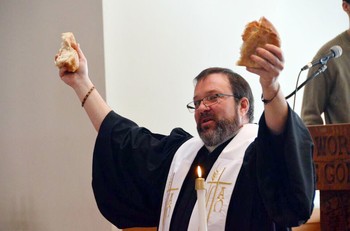For Christians the world over, the festival of Easter—the great day of resurrection—is not only the foundation of the faith but also the central event of the liturgical year.
And yet Easter isn’t just a Sunday. It’s also a season and a new way of life.
For the Rev. Dr. Chip Andrus, pastor of South Salem (New York) Presbyterian Church—who has previously served as an adjunct professor at Louisville Presbyterian Theological Seminary and a guest lecturer at the University of Dubuque Theological Seminary—it’s also a clarion call to keep liturgical time and practice.
“Because we do follow the lectionary,” said Andrus, “we’re very clear that we’re in a season of Easter.”
A season that, in fact, comprises a full seven weeks—the “Great Fifty Days”—ending with Pentecost. “I had one person tell me,” Andrus laughed, “that Easter never lasted this long in his life!”
The Rev. Dr. David Gambrell, associate for worship in the Presbyterian Mission Agency’s office of Theology and Worship, notes that the Christian season of Easter is patterned after Jewish practices, modeled on the fifty days between Passover and Shavuot, the “feast of weeks.”
“Our Easter season is a 'week of weeks'—seven times seven, or 49 days,” said Gambrell. “Pentecost, meaning ‘fiftieth day,’ is a day of jubilee: the conclusion of the Easter season and the culmination of this most joyful time in the Christian year.”
For Andrus, the Easter season is all about the sacraments, especially dying and rising with Christ in baptism and being fed at the table to be sent out. It was the practice of the early church that the Easter or Paschal Vigil—the occasion for baptism of new converts to the faith—would conclude in the wee hours of Easter Sunday with a celebration of the Lord’s Supper.
“First of all, it is important to know that South Salem Presbyterian Church celebrates weekly communion, and each Lord’s Day, water is seen and heard during the service, usually during the assurance of pardon,” he said.
Gambrell, who—in partnership with the Presbyterian Publishing Corporation, the office of Theology and Worship, and the Presbyterian Association of Musicians is overseeing a revised edition of the Book of Common Worship to be published by Westminster John Knox Press in 2018—says that for congregations that don’t already celebrate communion each Lord’s Day, as South Salem does, the season of Easter is the ideal time to explore weekly eucharist.
“Celebrating communion throughout the Easter season has the potential to transform people’s understanding and experience of the sacrament,” Gambrell said.
“This practice,” Andrus added, “allows us to be even more intentional during the Great Fifty Days of Easter about diving deeper into our baptism and celebrating communion with a greater sense of connection to how we live out the baptismal promises.”
Just as the season of Lent is a time to explore spiritual disciplines that draw Christians into deeper relationship with Christ, Gambrell believes the season of Easter can be similarly transformational.
“The fifty-day period of celebration from Easter to the Day of Pentecost can be a time to practice a new way of life in the risen Christ,” said Gambrell, “sharing the good news of Jesus’ resurrection in word and deed and following the spirit who is at work in the world.”
On Easter Sunday morning itself, Andrus said that because there are two primary stories at play, the congregation works with both of them.
“There’s the Easter morning story finding an empty tomb, and the Easter evening story, the Emmaus walk,” he said. “There’s baptism and table right there. The baptismal font is an empty tomb and womb of new birth. The communion table is where we recognize Jesus in the breaking of the bread. Throughout all of Easter, we try to very highly accentuate mystagogy in sermons and in liturgical practice, in other words, entering deeply into the mysteries of the sacraments. We’re not trying to explain them, we’re just trying to engage them more deeply.”
One way in which Andrus emphasizes the sacraments throughout the Great Fifty Days is by including a “remembrance” of baptism in every service, which he says differs from a “reaffirmation” of baptism.
“What we’re really doing when we confess our sins and are assured of pardon* [*see sample texts below] is remembering our baptism and living into it deeply,” he said. “And of course we have weekly communion.”
Andrus says that the 84-member church—in addition to being attuned to the liturgical year—is also very mission oriented.
“What we see throughout the Easter season is that our members are also framing the mission of the church around living into their baptismal vows to be the disciples that they’ve promised to be, and how that looks tangibly,” he said. “It’s the same with communion; we’re fed to feed others. Our practices really give momentum and deep sacramental grounding to the life and mission of the church during Easter because we’re engaging these things more intentionally.”
Which, for Andrus, is a very good thing.
“At the end of the fifty days, we move toward the biggest, annual community event that our church hosts, the South Salem Memorial Day Fair and Races,” he said. “It’s easy with such a big event like that to be wrapped up in the particulars that it becomes a chore. But now because we come out of Easter into it—and we’ve framed it through deeply engaging the community as a sacramental community as people who are baptized and people who are sent from the table—the whole atmosphere has changed. That’s true with other mission too.”

